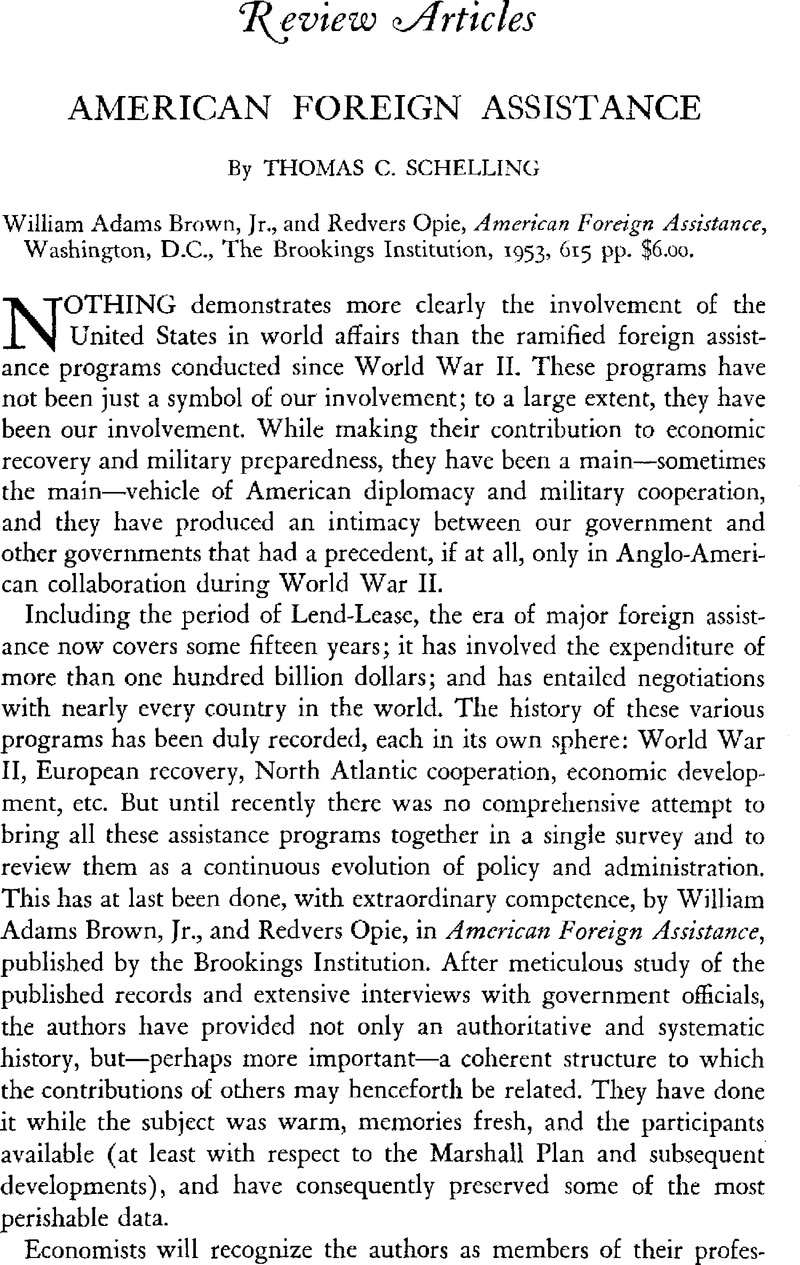Article contents
American Foreign Assistance
Published online by Cambridge University Press: 18 July 2011
Abstract

- Type
- Review Article
- Information
- Copyright
- Copyright © Trustees of Princeton University 1955
References
1 Commission on Foreign Economic Policy, Report to the President and the Congress, Washington, D.C., January 23, 1954, p. 8.Google Scholar
2 Mikesell, Raymond F., United States Economic Policy and International Relations, New York, 1952, p. 323, n. 17.Google Scholar
3 A similar disregard of substitution possibilities has often been implicit in the distinction between “strategic” and “non-strategic” items in East-West trade.
4 The legislative withholding of half of the 1953 military assistance funds for Europe until an EDC should come into existence was, according to the view expressed here, inept rather than inappropriate.
5 Professor Mikesell has expressed a similar view: “Since the deflationary effects of the counterpart funds can be offset by other means such as credit expansion and budgetary deficits, policies witb respect to their use must take into consideration the general monetary and financial program of the country concerned. Thus it would do little good to insist on the noninfiationary use of counterpart funds if the ERP country simply expanded purchasing power by some other means. In practice, the counterpart-funds arrangement has given ECA an opportunity to comment on the general fiscal and monetary policies of the aid recipients. Because of the political importance of balanced budgets and of preventing further increases in the quantity of money, participating countries have been eager to obtain approval for the release of these funds from ECA. This situation has provided an opportunity for the ECA and the NAC to influence internal financial policies of the participating countries and frequently to strengthen the hands of governments in inducing legislatures to adopt financial reforms” (op.cit., p. 266).
6 Professor Kindleberger projects the OEEC experience even further. Speaking of the “creative cooperative act” of OEEC in making recommendations for the division of aid, he says, “The type of sharing implied in this act is … the basis of forging many into one sovereignty” (Kindleberger, Charles P., International Economics, Homewood, Ill, 1953, pp. 494–95).Google Scholar
7 Some of these latter cases were subject to the mistaken interpretation that aid was given to permit an enlargement of foreign exchange reserves, since foreign exchange reserves naturally rise when the “budgetary assistance” is not accompanied by an offsetting import surplus. It would have been more correct to recognize the rise in reserves as a by-product (or at least a result of secondary importance) insofar as the motives for giving or requesting aid were concerned.
8 It was the two trends discussed in this section that made “trade, not aid” a somewhat less relevant choice than that slogan's popularity would suggest.
9 Agencies of the United States government have been known to get themselves in this position; to avert having to bail them out is one reason why the Budget Bureau “apportions” funds by quarters even though the year's budget is approved and the appropriation is in hand. Professor Smimies uses the term “coercive deficiency” to describe the practice. See Smithies, Arthur, The Budgetary Process in the United States, New York, 1955.Google Scholar Incidentally, his entire Chapter XVII, “Federal Grants-in-Aid,” bears a remarkable analogy to foreign assistance.
10 The last portion of Professor Mikesell's quoted remarks on counterpart funds is relevant here: “… an opportunity for ECA to … strengthen the hands of governments in inducing legislatures to adopt financial reforms” (pp.cit., p. 266).
- 6
- Cited by




